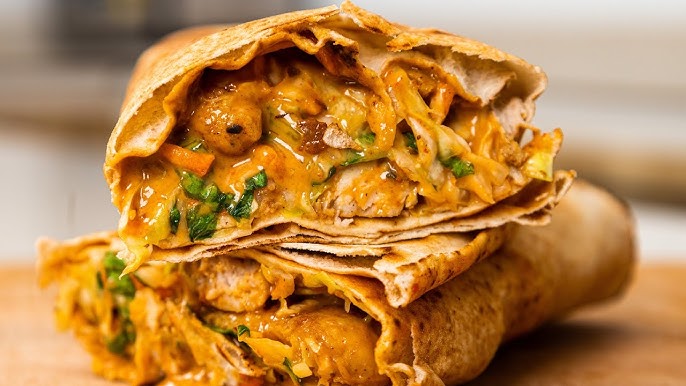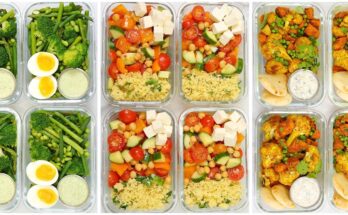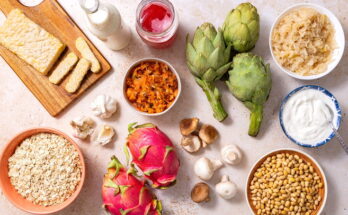Shawarma Recipe: Shawarma is a beloved Middle Eastern dish that has gained worldwide popularity for its savory, juicy meat wrapped in soft bread and loaded with fresh vegetables and creamy sauces. Originally cooked on a vertical rotisserie, shawarma is now recreated in kitchens everywhere. Whether you’re a fan of chicken, beef, or lamb, this step-by-step guide will walk you through making the perfect shawarma at home.
Ingredients Needed for Shawarma
For the Marinade
To create a flavorful marinade, you’ll need:
- Spices: Ground cumin, coriander, paprika, turmeric, cinnamon, and cayenne pepper.
- Herbs: Fresh parsley, garlic, and a touch of oregano.
- Liquids: Lemon juice, olive oil, and white vinegar.
- Extras: Salt, pepper, and a pinch of sugar to balance flavors.
Tip: Always use freshly ground spices to enhance the taste of your shawarma.
For the Filling
- Meat Options: Choose chicken thighs for juiciness, beef strips for richness, or lamb for a traditional taste.
- Vegetarian Alternatives: For plant-based options, use marinated tofu, roasted mushrooms, or falafel patties.
For the Wrap
- Bread Choices: Use soft pita, flatbread, or tortillas for wrapping.
- Gluten-Free Alternatives: Opt for lettuce wraps or gluten-free tortillas for a healthier option.
Preparing the Shawarma Marinade
Step-by-Step Marinade Preparation
- In a large mixing bowl, combine 2 tablespoons of olive oil, 1 tablespoon of lemon juice, and 1 tablespoon of white vinegar.
- Add 1 teaspoon each of cumin, coriander, paprika, and turmeric, along with a pinch of cinnamon and cayenne pepper.
- Mince 3 garlic cloves and chop fresh parsley, then mix them into the marinade.
- Add salt, pepper, and a small pinch of sugar. Whisk until smooth.
Pro Tip: Allow the spices to sit for a few minutes in the liquid for maximum flavor infusion.
Best Practices for Marinating the Meat
- Thinly slice your chosen protein (chicken, beef, or lamb) to allow the marinade to penetrate fully.
- Place the meat in a zip-top bag or shallow dish and pour the marinade over it.
- Seal and refrigerate for at least 4 hours, but overnight is ideal for deeper flavors.
- Turn the meat occasionally to ensure even coating.
Cooking the Shawarma
Grilling vs. Oven Roasting
For grilling:
- Preheat your grill to medium-high heat.
- Thread the marinated meat onto skewers and grill for 10–12 minutes, turning frequently.
For oven roasting:
- Preheat the oven to 400°F (200°C).
- Spread the marinated meat on a baking sheet and roast for 25–30 minutes, flipping halfway.
Using a Rotisserie for Authentic Shawarma
- If you have a rotisserie setup, layer the marinated meat on the rotisserie rod.
- Cook on medium heat for 1–2 hours, basting occasionally with leftover marinade.
- Thinly slice the meat directly off the rotisserie for a classic shawarma experience.
Preparing the Fillings and Sauces
Fresh Vegetables and Toppings
The beauty of shawarma lies in the variety of fresh toppings that balance the rich, savory flavors of the meat. Here’s what you’ll need:
- Vegetables: Shredded lettuce, sliced tomatoes, cucumbers, and thinly sliced red onions.
- Pickles: Pickled cucumbers or turnips for a tangy crunch.
- Extras: Sliced olives, jalapeños, or even roasted bell peppers for a pop of color and flavor.
Pro Tip: Chill your vegetables before adding them to the shawarma wrap. This adds a refreshing contrast to the warm meat.
Classic Shawarma Sauces
A good shawarma is incomplete without creamy, flavorful sauces. Here are a few must-haves:
Garlic Sauce (Touma)
- Ingredients: 1 cup of mayonnaise, 2 minced garlic cloves, 1 tablespoon of lemon juice, and a pinch of salt.
- Mix everything in a bowl until smooth. Adjust salt and garlic to your liking.
Tahini Sauce
- Ingredients: ½ cup of tahini, 2 tablespoons of lemon juice, 2 minced garlic cloves, and 3–4 tablespoons of water.
- Whisk together until creamy and smooth. Add water gradually to adjust the consistency.
Hot Sauce (Optional)
- Use a store-bought chili sauce or make your own by blending red chili paste with olive oil, garlic, and a touch of vinegar.
Pro Tip: Prepare sauces ahead of time and refrigerate them. This allows the flavors to meld beautifully.
Assembling the Shawarma Wrap
Step-by-Step Assembly Instructions
- Lay the Bread: Start with a fresh piece of pita, flatbread, or tortilla. Place it on a clean, flat surface.
- Add the Base: Spread a generous layer of garlic sauce or tahini sauce across the center of the bread.
- Layer the Meat: Place the cooked, sliced shawarma meat evenly on top of the sauce.
- Add the Vegetables: Layer shredded lettuce, tomatoes, onions, and pickles over the meat.
- Finish with Sauce: Drizzle another layer of your favorite sauce on top.
- Wrap it Up: Fold in the edges of the bread, then roll it tightly from one side to the other.
Pro Tip: Use parchment paper or foil to wrap the shawarma securely, especially if you’re serving it to-go.
Serving Suggestions
- Pair your shawarma with crispy fries or sweet potato wedges.
- Serve it alongside hummus or a light cucumber-yogurt salad.
- For a heartier meal, add a side of rice pilaf.
Tips and Tricks for Perfect Shawarma
Common Mistakes to Avoid
- Overcooking the Meat: This dries it out. Always cook on medium heat and check frequently.
- Skimping on the Marinade: The marinade is what gives shawarma its signature flavor. Be generous!
- Skipping Rest Time: After cooking, let the meat rest for a few minutes before slicing. This keeps it juicy.
Storage and Reheating Tips
- Leftovers: Store cooked meat in an airtight container in the refrigerator for up to 3 days.
- Reheating: Reheat meat in a skillet over medium heat or in the oven at 350°F (175°C) for 10 minutes. Avoid microwaving to preserve texture.
- Freezing: Marinated raw meat can be frozen for up to 3 months. Thaw in the refrigerator before cooking.
Variations of Shawarma
Regional Twists
Middle Eastern Style
- Features spices like cardamom, sumac, and allspice.
- Often paired with pickled turnips and tahini sauce.
Mediterranean Style
- Includes lighter herbs like oregano and rosemary.
- Commonly served with tzatziki sauce and feta cheese.
Indian-Inspired Shawarma
- Incorporates garam masala, ginger, and chili powder for a spicier kick.
- Can be paired with mint chutney or spicy yogurt dip.
FAQs about Shawarma Recipe
What is shawarma?
Shawarma is a popular Middle Eastern dish made from marinated meat that is stacked on a vertical spit and slowly roasted. It is commonly served wrapped in a flatbread like pita and topped with various condiments and vegetables.
What meats can be used for shawarma?
Traditionally, shawarma is made with lamb, chicken, beef, or turkey. The choice of meat depends on regional preferences and dietary restrictions.
What spices are needed to make shawarma?
The meat in shawarma is marinated with a blend of spices, typically including cumin, coriander, garlic powder, paprika, turmeric, and allspice. Variations might include cardamom, cinnamon, or cloves for additional flavor.
How long should meat marinate for shawarma?
For the best flavor, meat should marinate for at least 1 hour. However, for deeper infusion of flavors, marinating overnight in the refrigerator is highly recommended.
Can shawarma be made at home?
Yes, shawarma can be cooked at home using a grill or oven. While it won’t be exactly the same as the spit-roasted street food version, you can achieve a similar flavor and texture by thinly slicing the meat and cooking it on high heat.
What is typically served with shawarma?
Shawarma is often accompanied by toppings such as tahini, hummus, pickled vegetables, and fresh salads. It can be served on a plate with accompaniments or as a sandwich or wrap.
Is shawarma gluten-free?
Shawarma meat itself is gluten-free, but it is often served in pita bread. For a gluten-free option, you can serve shawarma with gluten-free flatbread or over a bed of rice or salad.
Conclusion
Shawarma is a truly versatile dish that combines bold flavors, fresh ingredients, and satisfying textures into one incredible meal. Whether you’re a meat lover or a vegetarian, shawarma can be tailored to your tastes. Plus, it’s easy to make at home with just a bit of preparation. Once you master the art of marinating and layering, you’ll never look at store-bought wraps the same way again.



